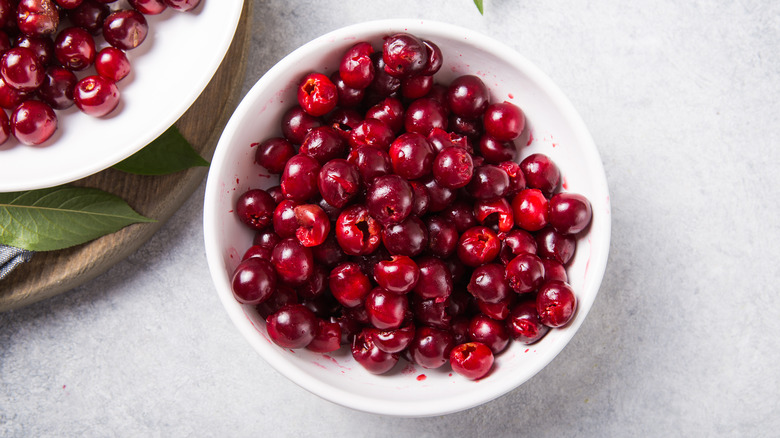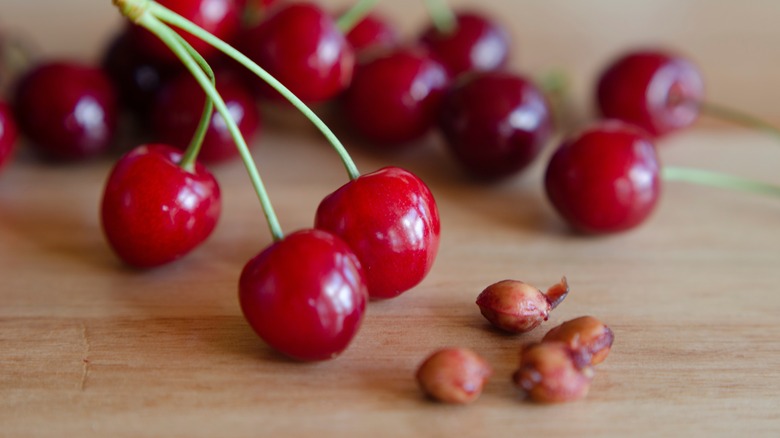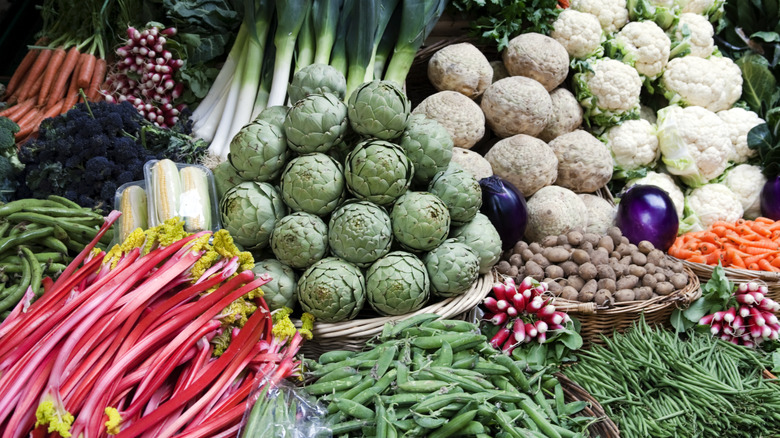What Happens If You Accidentally Swallow A Cherry Pit?
Sweet or sour, cherries are a fruit lover's dream. Between their ruby red color and juicy flesh, fresh cherries are delicious on their own as a snack and just as tasty when par-cooked for the perfect pie filling or turned into maraschino cherries for cocktail garnishes. The main con of cooking or eating them is dealing with the pesky pits. Along with peaches and plums, cherries are classified as a stone fruit, aptly named for the hard and inedible seed-shielding pit at their center. The hand-staining and time-consuming process of removing these small stones can be annoying even with a dedicated pitter. And sometimes, cherry pits can accidentally slip through.
So, what happens if you swallow a cherry pit? Usually, nothing. However, they still aren't safe to eat. Slightly smaller than a marble, cherry stones are a choking hazard, and swallowing too many can also lead to blockages in the intestinal tract. Most importantly, though, you should avoid chewing on them. Biting down on a pit not only puts you at risk of cracking a tooth, but of poisoning, too.
Stone fruit pits contain amygdalin, a compound that the human body converts into hydrogen cyanide. Fortunately, the chances of falling victim to self-inflicted cyanide poisoning from cherry pits are extremely low. According to Poison Control, seeds that contain amygdalin have to be crushed or chewed before swallowing in order for the chemical to be released. As long as you don't crack open any cherry pits and gnaw on their seeds, there's little cause for concern.
Swallowing a cherry pit is rarely a poison risk
You've probably noticed that cherries don't come with a warning label about cyanide poisoning — because the potential risk posed by the pits is minimal. Most of the time, nothing happens when a person swallows a cherry pit as the danger lies inside of it. Since stone fruit pits serve as a protective barrier for the amygdalin-containing seeds, they should pass through the digestive tract intact if the hard kernels aren't chewed.
However, crushing cherry pits with your teeth until they break open can be extremely dangerous. In 2017, a person in the United Kingdom was hospitalized for cyanide poisoning after cracking open several pits and eating the seeds inside (via Global News). While fatal doses of cyanide range between 1-2 milligrams per kilogram of body weight, symptoms such as dizziness, nausea, and chest pain can occur after ingesting smaller doses. Since the amygdalin content of cherry pits differs based on the species of fruit, it's difficult to say exactly how many would pose a poison risk. For instance, an article published in the Food Chemistry journal reports that a red cherry pit contains about 3.9 milligrams of the chemical per gram, while a Morello cherry pit contains as much as 65 milligrams per gram.
Still, the chances of being poisoned from swallowing a cherry pit (or several) are extremely low as long as you avoid chewing them. Of course, if you are ever concerned or have any questions about ingesting one, there's no harm in contacting Poison Control.
Other produce parts that are potentially poisonous
If you were told as a child to avoid gnawing on apple cores because you might sprout a tree in your stomach, the only danger of an apple core lies in the fruit's tiny seeds, which also contain amygdalin. As with cherries, accidentally swallowing an apple seed or several shouldn't be an issue so long as you aren't chewing on hundreds or thousands of them. However, like so many other old wive's tales, this warning serves as a welcome reminder that not all parts of produce are safe to eat.
While it's a common practice to reduce food waste by making the most of your fruits and veggies, whether you turn carrot tops into pesto or add the orange peels to homemade veggie stock, there are some food scraps you should avoid eating. According to the World Health Organization, some edible plants have natural toxins that can cause side effects when consumed. Like stone fruits, cassava and bitter almonds also contain cyanogenic glycosides, compounds that are converted to cyanide by the body. Additionally, rhubarb leaves feature a couple of different dangerous chemicals; you should also avoid eating green potatoes and potato sprouts. While some of these natural toxins may just lead to an upset stomach, others can be more serious if you ingest poisonous parts in large quantities. To avoid any unwanted health issues when cooking, it's worth researching how best to prep produce. Pitting cherries may not seem so troublesome after all.


